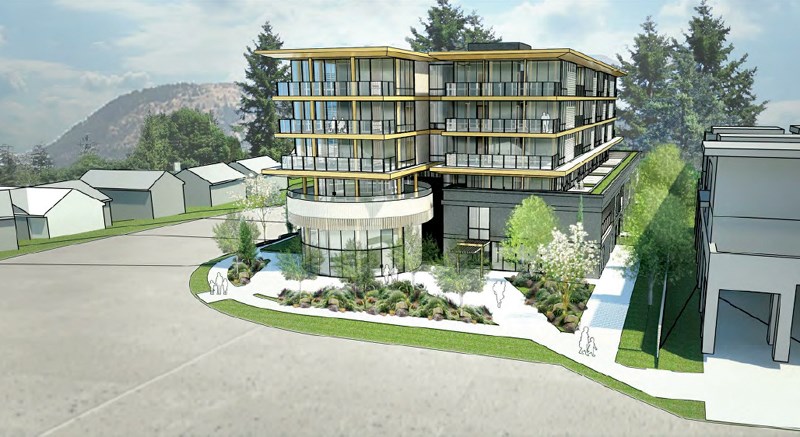Neighbours lined up at a public hearing last Wednesday to oppose a six-storey condo development proposed for the intersection of Wharf Avenue and East Porpoise Bay Road in Sechelt.
More than a dozen residents spoke against the project, saying the 19.6-metre building height would result in loss of views, privacy, sunlight and property values for surrounding homes, some dating back 100 years.
“This building will tower over the three-storey complex [next door], blocking out light which is required for healthy living conditions for all concerned,” said Wharf Avenue resident Pat Jorgensen. “The height of the proposed complex is not conducive to this particular area.”
“My street – it’s going to destroy the character,” another woman said. “I think I’m going to look at Powell River, after 50 years in Sechelt. It breaks my heart.”
Judy Hoeppner, who lives on East Porpoise Bay Road directly across from the site, said she has installed solar panels that will become “absolutely useless” if the building goes up. “I’m a little choked about that,” she said.
Neighbour Will Mason said his property would lose afternoon light, and its privacy:
“I don’t want six storeys of people looking through my windows.”
Mason and several other residents also voiced concern over the lack of on-street visitor parking and traffic congestion around the intersection, which is controlled by four-way stop signs. “The traffic capacity for East Porpoise Bay Road is already stressed,” he said. “I don’t see how the four-way stop can service that much traffic.”
Pat Dalgleish of Ebbtide Street said it was “ridiculous” to increase traffic in the area. “It’s an accident waiting to happen.”
Parking, said Shirley Hall of Osprey Street, “is a problem now. It’ll be far, far worse if this development goes through.”
The proposed Official Community Plan and zoning bylaw amendments would allow 47 residential units and 93 sq. metres of first-floor commercial space. The building would occupy three properties at the southeast corner of the intersection and would have 82 stalls of underground parking. In exchange for increased density, the developer would provide five units of affordable housing and build to accessible or adaptable and Green Gold or better standards.
Project architect Brad McTavish, speaking first at the hearing, said the added density and six-storey configuration would enable the developer to create the five affordable units and make the other units more economical for potential buyers.
Adam Major of Holywell Properties said he empathized with the affected residents but argued that Sechelt needs more density to address the housing supply shortage. Condo developments such as the adjacent Wharf Place and The Watermark, he said, are in effect providing purpose-built rentals through the units rented out by owners.
“Limiting the supply of housing is kind of what’s led to this crisis we’re having,” Major said, adding that growth in the downtown core is good for the community and benefits the district’s bottom line. “These more dense developments help subsidize single-family housing.”
Accessibility advocate Bill Conway of Inlet Avenue said he opposed the project due to the increased vehicle traffic it would bring. He called for improvements to make the intersection more pedestrian-friendly, describing it as one of Sechelt’s worst intersections “to cross for a person with no sight.”
A staff report summarizing the input from the public hearing is expected to come back to council on June 20, director of planning and development Tracy Corbett confirmed Monday. Corbett said the report would present options for council to either proceed to second and third reading, deny the application, or refer it back to staff to work with the applicant to revise as council directs.



